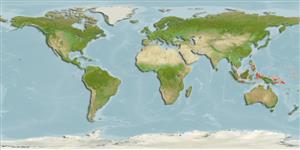Common names from other countries
Ελασμοβράγχιοι (καρχαρίες και σαλάχια) (sharks and rays) >
Orectolobiformes (Carpet sharks) >
Hemiscylliidae (Bamboo sharks)
Etymology: Hemiscyllium: hemi-, from hemisys (Gr.), half, presumably referring to similarity and/ or close affinity to Scyllium (=Scyliorhinus, now in Scyliorhinidae) and/or Chiloscyllium; skylion, Greek for dogfish or small shark. (See ETYFish); galei: In honor of underwater photographer and shark enthusiast Jeffrey Gale, who successfully bid to help conserve this species at a charity auction, and who financially supported Conservation International’s efforts to preserve its habitat. (See ETYFish).
Environment: milieu / climate zone / depth range / distribution range
Οικολογία
Θαλασσινό(ά) Υφαλόφιλο(α); εύρος βάθους 2 - 25 m (Ref. 114942). Tropical
Western Pacific: apparently confined to Cenderawasih Bay, Papua Barat Province, Indonesia.
Μέγεθος / Βάρος / Age
Maturity: Lm ? range ? - ? cm
Max length : 56.8 cm TL αρσενικό/απροσδιόριστο; (Ref. 74956)
Short description
Κλείδες προσδιορισμού | Μορφολογία | Μορφομετρία
This species of bamboo shark is distinguished by its unique combination of white lines/spots along the margin of the large, dark saddles on the back, scattered white spots particularly on the upper side, and a row of 7-8 well-defined, horizontally-ovate, dark spots on the lower side between the abdomen and caudal-fin base (Ref. 74956).
Occurs on shoreline fringing reefs or shallow patch reefs; observed at night at depths of 2-25 m (extreme depth from Ref. 114942), usually seen resting on the bottom, occasionally observed while slowly swimming or 'walking' over the bottom with the pectoral and pelvic fins. Probably sedentary during daylight hours, sheltering under rocky outcrops or tabular corals, typical for other family members (Ref. 74956).
Life cycle and mating behavior
Maturities | Αναπαραγωγή | Spawnings | Egg(s) | Fecundities | Προνύμφες
Allen, G.R. and M.V. Erdmann, 2008. Two new species of bamboo sharks (Orectolobiformes: hemiscylliidae) from Western New Guinea. aqua, Int. J. Ichthyol. 13(3-4):93-108. (Ref. 74956)
IUCN Red List Status (Ref. 130435)
CITES (Ref. 128078)
Not Evaluated
Threat to humans
Harmless
Human uses
Εργαλεία
Special reports
Download XML
Διαδικτυακές πηγές
Estimates based on models
Preferred temperature (Ref.
115969): 28.1 - 29.2, mean 28.8 (based on 448 cells).
Phylogenetic diversity index (Ref.
82804): PD
50 = 0.5020 [Uniqueness, from 0.5 = low to 2.0 = high].
Bayesian length-weight: a=0.00407 (0.00181 - 0.00918), b=3.09 (2.89 - 3.29), in cm Total Length, based on LWR estimates for this (Sub)family-body shape (Ref.
93245).
Τροφικό Επίπεδο (Ref.
69278): 3.4 ±0.3 se; based on size and trophs of closest relatives
Fishing Vulnerability (Ref.
59153): Moderate vulnerability (43 of 100).
